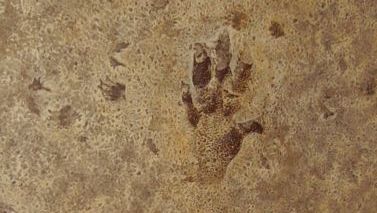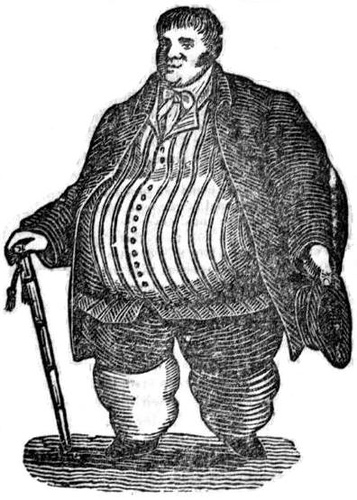
200 million years ago, a creature called Cheirotherium stepped in some German mud.
That’s all we know about it — no remains have ever been found.

200 million years ago, a creature called Cheirotherium stepped in some German mud.
That’s all we know about it — no remains have ever been found.
June 30, 1811. A few days ago, John Hall, a labouring man, went at low water among the rocks, at Hume Head, near Cawsand, for the purpose of catching crabs, when meeting with one in the interstices of the rocks, of a large size, he imprudently put in his hand, for the purpose of pulling it out; the animal, however, caught his hand between its claws or forceps, and, strange as it may appear, kept its hold so firmly, that every effort on the part of the poor fellow to extricate himself proved ineffectual; and no one being at hand to assist him, the tide came in and he was next morning found drowned.
— National Register, 1811

In 1808, a large decomposing corpse washed up on Scotland’s Orkney Islands. It was enormous — 55 feet long, including a 15-foot “neck” — and the Royal Museum in Edinburgh decided it must an unknown species of sea serpent.
London anatomist Sir Everard Home later concluded it was a basking shark, but still it’s an enigma — the largest previously recorded basking shark had been 40 feet long.

The keeper of an 18th-century workhouse, Daniel Lambert insisted that he ate moderately and avoided alcohol, but the evidence suggested otherwise. By age 23 he weighed 448 pounds; at 36 he hit 700 pounds and began to finance customized furniture and clothing by touring local cities and charging gawkers a shilling apiece to look at him. When he died in 1809, at age 39, he was 5 feet 11 inches tall and weighed 739 pounds. The wall of the public house in which he was staying had to be dismantled to remove his body.
In the foyer of the Department of Physics at New Zealand’s University of Otago is a clock that has been running continuously since 1864. The “Beverly Clock” is driven by variations in atmospheric pressure and by daily temperature variations, so it never needs winding.

February 20, 1766, Richard Persons, and three other persons, met at a private house in Chalford, in order to play at cards. Though only nineteen years of age, he was very guilty of swearing, and using bad language. A dispute arising while thus engaged, he wished that his flesh might rot upon his bones, and frequently repeated this expression, with many others equally shocking. The party continued to play to a very late hour; and before they broke up Parsons felt a pain in his leg, and complained of it to his partner, of the name of Rolles. From that time it increased, and he went to Minchinhampton, to get advice of Mr. Pegler, a surgeon, who found that a mortification had taken place. All possible means were taken to prevent its spreading, but nothing could save him: it flew from his legs to various parts, viz. under his eyes, and the tops of his shoulders, and on one hand; and he died in twelve hours after it so spread, on the 4th of March in the morning, a most shocking spectacle.
— Annual Register, 1766
In the 1970s, Anthony Hopkins won a role in the film The Girl From Petrovka. The story was based on a novel by George Feifer, and Hopkins sought it out in several bookstores, without success. He was waiting at the Leicester Square underground station when he noticed a discarded book on a bench nearby. It was The Girl from Petrovka, with notes written in the margins.
Two years later, while shooting the project in Vienna, Hopkins met Feifer, and during their conversation he learned that the novelist had no copy of the book. He had lent his to a friend, who had lost it somewhere in London.
Incredulous, Hopkins handed him the book he had found two years earlier. “Is this the one?” he asked. “With the notes scribbled in the margins?” It was Feifer’s book.
July 5, 1766. At eight o’clock in the evening, a man who had laid a wager to cross the Thames in a butcher’s tray, set out in the same from Somerset Stairs, and reached the Surrey shore with great ease, using nothing but his hands. He had on a cork jacket, in case of any accident. It was said 1400l. was depending on this affair; and upwards of seventy boats full of spectators were present.
— Annual Register, 1766
On March 23, 1944, RAF tail gunner Nick Alkemade was over Berlin when a Luftwaffe attack set his bomber ablaze.
His parachute was in the flaming cabin, so he resigned himself to a quick death and jumped without it.
Alkemade fell head down for 18,000 feet, trying to relax and thinking of death. But after the impact he found himself looking up at the stars through a canopy of pines. The trees and snow had apparently slowed his fall, and he escaped with only a sprained leg.
The Gestapo refused to believe his story until they found his burned parachute at the crash site.

In the beginning of September 1792, a paragraph appeared in several newspapers, mentioning that a hawk had been found at the Cape of Good Hope, and brought from thence by one of the India ships, having on its neck a gold collar, on which were engraven the following words:
“This goodlie Hawk doth belong to his Most Excellent Majestie, James Kinge of England, A.D. 1610.”
— Kirby’s Wonderful and Scientific Museum, 1820